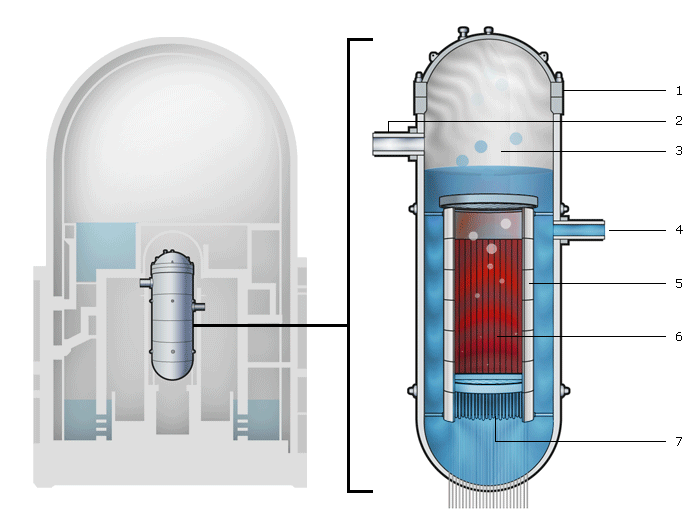
The end of a Swiss nuclear power plant

On November 27, Swiss voters will decide whether to turn off the country’s nuclear power stations after 45 years of activity. But what does dismantling a nuclear power plant involve? What are the difficulties? swissinfo.ch looks at the example of Mühleberg.
It’s a Swiss first: on December 20, 2019, the Mühleberg nuclear power plant in canton Bern will definitely be disconnected from the grid. A new chapter in the history of Swiss nuclear energy will thus begin: the complete dismantling of a power plant.
“It’s the biggest project we’ve faced since the plant was constructed 40 or so years ago,” said Sabrina Schellenberg, spokeswoman for BKWExternal link, the operator of Mühleberg plant.
Situated around 15 kilometres from the Swiss capital Bern, the reactor has been in service since 1972 and provides 5% of the electricity used in Switzerland.
“The main challenge is legal and administrative. Gathering all the documentation, working out the deactivation project and getting decommissioning approval will require a lot of time. It will be necessary to respect the framework conditions and involve all parties, from direct interests to the population, the cantons and the federal authorities,” she said, adding that BKW had started the process in 2013.
The purely technical aspect on the other hand does not seem to be a problem.
“We know the technical challenges involved in dismantling a power station – this has been done many times abroad, in Germany in particular,” Schellenberg said.
And it’s Germany that will provide the bulk of the advice and expertise.
“Safety is the absolute priority,” said Werner Süssdorf, project leader at the German energy company EWNExternal link, which was responsible for dismantling the MZFR research reactorExternal link in the southern Germany city of Karlsruhe.
“This is why the dismantling will happen from the inside out. The outer wall acts as a barrier to avoid any radioactive escape.”
‘Routine operation’
It will also be a German who will guide the dismantling of Mühleberg. Stefan Klute, a BKW engineer, says the first phase consists of cooling the nuclear fuel, or rather the uranium rods.
Once the fuel is extracted from the reactor core, it will be submerged in the so-called deactivation pool, where it will stay for several years.
“Water is an effective barrier against radiation and allows us to cool the combustible elements,” Klute said, adding that doing this is nothing exceptional.
“It’s a routine operation that we carry out during each annual control.”
Around 2024, the cooled uranium will be transported by lorry to the interim storage facility at Würelingen, canton Aargau. At this point, 98% of the radioactivity will have been eliminated by Mühleberg and there will be practically no risk to the population, according to Klute.
It will then be possible to begin the real disassembly of the cement and steel structure, starting with the reactor core. This is the most complex phase, says Martin Brandauer, an engineer at the Karlsruhe Institute of TechnologyExternal link, one of the global centres of expertise for dismantling nuclear power stations.
“Fifty years ago, when a power station was built, no one thought about dismantling it. The old plants were made in an extremely compact manner for reasons of cost and safety. Therefore there isn’t much space for the dismantling and decontamination,” he told swissinfo.ch.
One source of help in this respect is provided by technology. “We’re working with virtual reality, for example. We’re developing robots with a view to improving efficiency and staff safety,” Brandauer said.

‘Fast version’
At Mühleberg, unlike what has been done in the United States for example, the so-called “fast” version will be used.
“Dismantling this [boiling water] type of reactor is well-known and therefore we’ll be able to begin directly,” said Stefan Klute. “In other places the preference is to seal the plant for 40-50 years and wait for some of the residual radioactivity to decay naturally.”
In his opinion, there are many advantages to the more rapid option.
“We don’t have to second-guess what the political situation will be in half a century – an impossible prediction in any case. We don’t want to bequeath this to the next generation and, what’s more, we can count on the experience of our co-workers.”
Dismantling the Mühleberg nuclear power station will generate around 200,000 tonnes of waste. Most of the material will be decontaminated directly in situ and recycled or disposed of in appropriate landfills.
The whole operation should finish around 2034, as this film clip explains:

More
Terminating a nuclear power plant
All bases covered?
So everything at Mühleberg will run smoothly? Several environmental organisations are warning that unpredictable events, by definition, can’t be ruled out.
Switzerland’s lack of experience in dismantling nuclear power plants could become apparent, said Greenpeace, noting that there isn’t a predefined method for disassembly. It pointed out that every reactor was different and experiences in France and Germany showed that there are always delays and additional costs.
As for safety, the Swiss Energy FoundationExternal link, which favours a nuclear withdrawal, says the measures undertaken by BKW seem good. “But we’ll be following the process with a critical eye,” said director Jürg Buri.
This monitoring will be essential, given that the experience at Mühleberg will be useful when dealing with Switzerland’s other power stations.
“It’s like a railway line,” Klute says. “We’re responsible for our train, but we’re laying the tracks for the entire sector.”
Translated from Italian by Thomas Stephens

In compliance with the JTI standards
More: SWI swissinfo.ch certified by the Journalism Trust Initiative
















![The four-metre-long painting "Sonntag der Bergbauern" [Sunday of the Mountain Farmers, 1923-24/26] had to be removed by a crane from the German Chancellery in Berlin for the exhibition in Bern.](https://www.swissinfo.ch/content/wp-content/uploads/sites/13/2025/12/01_Pressebild_KirchnerxKirchner.jpg?ver=cb688ed5)















You can find an overview of ongoing debates with our journalists here . Please join us!
If you want to start a conversation about a topic raised in this article or want to report factual errors, email us at english@swissinfo.ch.